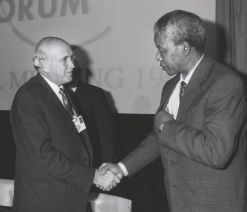
20 Years of Freedom
by Janine Erasmus “I wish to put it plainly that the government has taken a firm decision to release Mr Mandela unconditionally. I am serious about bringing this matter to finality without delay.” With those words, said on 2 February 1990, then-state president FW de Klerk set a remarkable chain of events in motion. An […]

by Janine Erasmus

“I wish to put it plainly that the government has taken a firm decision to release Mr Mandela unconditionally. I am serious about bringing this matter to finality without delay.”
With those words, said on 2 February 1990, then-state president FW de Klerk set a remarkable chain of events in motion. An electorate that, to a large extent, was enjoying the right to vote for the first time in their lives, led to a democratic South Africa with one of the most progressive constitutions in the world.
De Klerk, who had assumed the presidency just four months earlier, wasted no time in bringing about long-overdue change.
He was making his inaugural State of the Nation address at the 1990 opening of Parliament in Cape Town, speaking before the House and to a television audience.
South Africa will mark the 20th anniversary of Nelson Mandela’s release from more than 27 years of imprisonment at the opening of Parliament on 11 February.
The 2010 event will also be significant as it will be the first time the State of the Nation address is delivered in the evening. By arranging the speech for a more convenient television time, rather than the traditional morning delivery, the government is encouraging more citizens to tune in.
Understanding through dialogue

Addressing the nation in 1990, De Klerk went on to say that the agenda for negotiation was now open. He invited “sensible” leaders to come forward and begin talking, so that an understanding may be reached through dialogue.
De Klerk’s government had a number of firm goals in mind, among them a new democratic constitution; protection of minorities and the rights of the individual; an independent, unbiased judiciary; religious freedom; better housing, education, social and health services for all; and a strong economy.
This could only be achieved with the abolition of apartheid laws and restrictions, a fact of which De Klerk was very well aware.
Not only did the president decide to release Mandela, he implemented other changes on a scale that nobody had anticipated.
Several political parties were unbanned. These were the African National Congress (ANC), the Pan Africanist Congress, and the South African Communist Party. He also lifted restrictions on 33 other opposition groups. Prisoners who were in jail merely for belonging to one of the banned organisations were pardoned immediately.
De Klerk also lifted certain media, education and security restrictions, paving the way for the eventual lifting of the latest state of emergency, by then in place since 1985. The death penalty was suspended and the controversial and deplorable Land Act was repealed.
The remaining apartheid laws were dismantled over the next three years, and South Africa’s first democratic election took place in 1994. It was no surprise that Mandela stepped into the role of leader of the nation.
Peace and reconciliation
The country had endured tension and violent conflict for decades, said De Klerk, and it was time to break out of that cycle and strive for peace and reconciliation. The silent majority yearned for it, he said, and the youth deserved it.
De Klerk was emphatic in urging South Africans to come to the negotiation table. “On the basis of numerous previous statements there is no longer any reasonable excuse for the continuation of violence. The time for talking has arrived and whoever still makes excuses does not really wish to talk.”
His decisive actions, which would eventually cut short his own political career as he made way for a new party to take over the government, earned him the praise of the nation, and the world.
Archbishop Emeritus Desmond Tutu, speaking to the press at the time, exclaimed: “What he said has certainly taken my breath away … give him credit, man.”
The BBC reported then-US president George Bush as saying that he welcomed the decision to dismantle apartheid, although more had to be done before the US would lift its economic sanctions. And Margaret Thatcher, then prime minister of Britain, wrote a congratulatory letter to De Klerk.
Others, such as current UN secretary-general Perez de Cuellar and presidents Mario Soares of Portugal, Francois Mitterand of France, and Kenneth Kaunda of Zambia, also expressed their joy and approval.
Some were more cautious. The late ANC president Oliver Tambo, speaking from Stockholm where he was receiving treatment for a stroke, described De Klerk’s steps as progressive, but pointed out that two of the ANC’s main demands were not fully realised – the release of all political prisoners, and the complete lifting of the state of emergency.
Long-awaited release
Nelson Mandela was released on 11 February 1990 from the low-security Victor Verster prison, now known as the Drakenstein Correctional Centre, in the Dwars River valley near Paarl, Western Cape.
Mandela had been relocated from Robben Island to the maximum-security Pollsmoor Prison in Cape Town’s southern suburbs in 1984, and a few years later he was moved to a private house within the prison walls of Victor Verster.
“When he built a home in Qunu after his release,” said Mandela’s daughter Zindzi, “he insisted that it be a duplicate of his house in Victor Verster, where he felt comfortable. My father often said that he missed his time in prison because it allowed him time to reflect.”
Zindzi Mandela received news of her father’s imminent release while she was at the funeral of her partner Clayton Sithole, who died while in detention at the former John Vorster police station, Johannesburg, in January 1990, just 12 days before Mandela walked free.
She described the day of her father’s release as emotional, painful and chaotic. “I was terrified. There were so many people, which I never expected. As much as I wanted him to come home as a father, I knew he would come back as a leader first.
And I was in mourning for the father of my child.”
Straight after his release Mandela addressed thousands of supporters from the balcony of the Cape Town city hall. He spent his first night of freedom at Bishopscourt, the official residence of the Archbishop of Cape Town, who at that time was Desmond Tutu.
Mandela flew to Johannesburg the next day, where he attended a rally at Soweto’s FNB stadium, now the impressive Soccer City and venue for the opening match of the 2010 Fifa World Cup. From there he went to his house in Vilakazi Street, Soweto, where he spent his first night at home in almost three decades.
In 1993 De Klerk and Mandela jointly received the Nobel Peace Prize for their work in abolishing the apartheid policies that had held South Africa back for so long. The Nobel Committee awarded this prestigious honour “for their work for the peaceful termination of the apartheid regime, and for laying the foundations for a new democratic South Africa”.
The laureates also jointly received the 1991 Unesco Félix Houphouët-Boigny Peace Prize.
The announcement of the latter prize, made by former US Secretary of State Henry Kissinger, read: “For their contribution to international peace, to encourage them to continue in their effort and as a tribute to what they have done to educate their people towards an understanding and towards an overcoming of prejudice that many would not have thought possible a few short years ago.”
Bringing the struggle to life
In February 2009 the National Heritage Council announced the first site in the new National Liberation Heritage Route (LHR) – the house at Victor Verster prison where Mandela spent the last few years of his incarceration.
Making the announcement, CEO of the National Heritage Council Sonwabile Mancotywa said that the prison had transformed from a place of pain to one that honoured the final stretch in the struggle for freedom. “It is a place of history that has contributed to South Africa’s cultural revival,” said Mancotywa.
Mandela’s former wife Winnie Madikizela, also in attendance, expressed her pleasure that the LHR was going all out to recognise the country’s struggle heroes: “We hope that it can include the history of all those who gave up their lives for freedom,” she said, “and tell the story of the Tambos and the Sisulus and others as much as the Mandela story has been told.”
The South African LHR, a network of historically valuable sites that reflects key aspects of the country’s struggle for freedom, is modelled on the Australian convict sites. In July 2007 it was submitted to Unesco for nomination as a world heritage site, and is currently on the tentative list.
The route consists of a host of stops that cover critical aspects of the liberation struggle, such as the women’s movement, youth and student movements, massacres and assassinations, and sites of historical significance.
A few examples are Constitution Hill, once a notorious prison and now seat of South Africa’s Constitutional Court; Sharpeville, site of the massacre in 1960 where 69 protesters died; the Isandlwana battlefield, where Zulus and British colonial troops faced off in 1879; and Olive Schreiner House in De Aar, Northern Cape, once the home of the renowned author of The Story of an African Farm and opponent of women’s oppression.
The Mandela section of the route includes his birthplace Mvezo in Mthatha, Eastern Cape province; Qunu in Mthatha where he grew up; the Clarkebury Institution which schooled him; the house in Alexandra, Johannesburg, where he lived for three years in the early 1940s; Fort Hare University; the site in Howick where he was captured by police in 1962; Liliesleaf Farm; Robben Island; Victor Verster prison; and the Mandela family home in Vilakazi Street, where Winnie lived with their children while he was in prison.
It is hoped that other countries in the Southern African Development Community will make similar submissions.